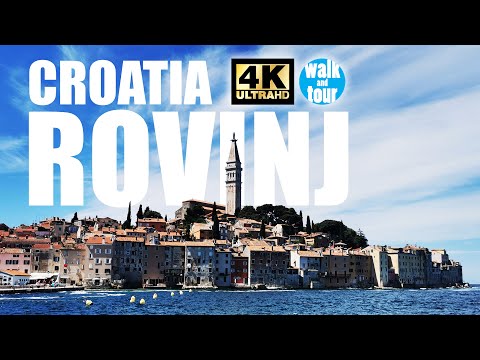Rovinj - Narrow Streets and Romantic Sea Views Walk - Croatia - 4K UHD

Rovinj is a city in Croatia situated on the north Adriatic Sea with a population of about 15 000. Located on the western coast of the Istrian peninsula, it is a popular tourist resort and an active fishing port. The town is officially bilingual, Italian and Croatian. Surrounded by a myriad of colors, sounds and smells, at the market you can really find almost anything. From fresh, local fruits and vegetables, cheese, asparagus, mushrooms, indigenous local products, liqueur, honey, ... ... while fresh fish can be found in the fish market which is located within the market. Rovinj was already a settlement of Venetian or Illyrian tribes before being captured by the Romans.
Built on an island close to the coast, it became connected to the mainland much later, in 1763, by filling in the channel. Rovinj was incorporated into the Byzantine Empire, later becoming part of the Exarchate of Ravenna in the 6th century. In 788, Rovinj was taken over by the Frankish Empire. For the following several centuries it was ruled by a succession of feudal lords ... ... and in 1209 it was acquired by the Patriarchate of Aquileia under Wolfger von Erla. VLADO has my respect! He surely knows, how to handle his van.. :)
From 1283 to 1797 Rovinj was one of the most important towns in Istria governed by the Republic of Venice. During this period three town gates were constructed and Rovinj was fortified by two rows of defensive walls Nearby the Rovinj pier is one of the old town gates, the Balbi's Arch, dating from 1680, and a late-Renaissance clock tower. The Church of St. Euphemia is a Baroque church located in the heart of the historic part of the city. This three-nave church was built from 1725–36, over the remains of older, early Christian structures. The dedication was originally to Saint George, later to Saints George and Euphemia. The present building is dedicated to Euphemia only Its façade dates from 1883.
The church contains several treasures and works of art: Gothic statues from the 15th century, paintings from the 16th and the 17th centuries: Last Supper and Christ in the Gethsemane. The bell tower resembles the tower of St Mark's Basilica in Venice. It was built during 1654–1680, to the plans by Antonio Manopola.
On top of this 60 m-high tower stands the statue of Saint Euphemia, serving as a wind vane. Following the fall of Venice in 1797 and the ensuing Napoleonic interlude, Rovinj became part of the Austrian Empire ... ... , which lasted until World War I. It then belonged to Kingdom of Italy from 1918 to 1947, when it was ceded to SFR Yugoslavia, During the post-war period many Italian inhabitants left Rovinj, ... ... which led to significant changes to the city's demographic structure. Following Croatia's independence in 1991, the town became one of the most important centers of Istria County. Rovinj is today the third most populous town in the county, behind Pula and Poreč.
Balbi's Arch was built in 1678–79. On one side, there is the carved head of a Turk while on the other is the carved head of a Venetian. The main economic activity in Rovinj is tourism. During peak season (May–September), its bars, restaurants and art galleries work long hours. The busiest area is the very centre of Rovinj ... ... extending from the main bus station towards the old part of town, where most bars and clubs are located. The town's main central thoroughfare is the fully pedestrian Carrera Street, with many independent shops and art galleries.
Rovinj is the second biggest tourist destination in the county, in terms of overnight stays. During the summer season, there is a direct high speed ferry link between Venice and Rovinj. High speed weekly lines to the Port of Ravenna and Cesenatico are also available in the summer. There are numerous hotels in the town itself, and beds are abundant though usually overbooked in the summer months. Apart from hotels on the mainland, there are also a handful of hotels on small islands surrounding Rovin.
There are numerous hotels in the town itself, and beds are abundant though usually overbooked in the summer months. Accommodation ranges from private rooms or apartments to bungalows, camping sites and 2 to 5 star hotels. The preferred means of transport for getting around Rovinj is by car. Rovinj is well-connected with the rest of Istria and with larger cities in the region such as Trieste, Rijeka, Ljubljana and Zagreb. The closest commercial international airports are: Pula/Pola, Trieste-Ronchi and Rijeka-Krk.
Car rental is available at each of the airports. Rovinj is served by the Kanfanar railway station, which connects the region to Rijeka/Fiume. However, travelling by bus is preferred to travelling by train due to the limited connections and schedules. The main bus station is located at the south-east end of Carrera Street.
A farmer's market is located at the edge of the historic part of town, near Valdibora Square.
2021-08-18 13:55


